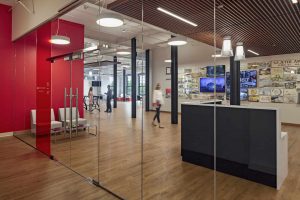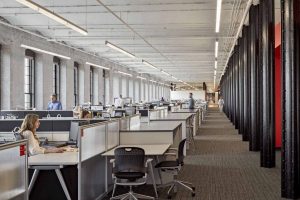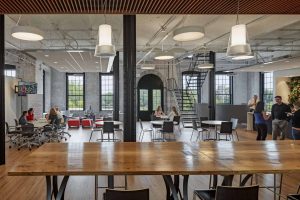by James E. LaPosta Jr.
Earlier this year, JCJ Architecture set out to find a new location for its Hartford, Connecticut studio — one that would enhance teamwork, promote serendipitous encounters, and offer a variety of spaces to support individual work styles and diverse project needs. The former Colt Armory, a historic factory complex built before the Civil War era, provided the perfect opportunity to create an agile workplace within the framework of a rich and textured industrial landmark that promotes collaboration, productivity, and brand expression.
After a fire destroyed a portion of the Colt Fire Arms complex in 1865, Elizabeth Colt rebuilt the factory and operations founded by her husband. Located along the Connecticut River and just south of Downtown Hartford, the building was a marvel for its time. With its iconic blue onion dome, 3-foot thick masonry walls, and long, narrow shop floors, the Colt East Armory was a center of 19th century U.S. industrial innovation.
The very characteristics that made the Colt Armory a highly successful manufacturing hub for 125 years — high ceilings, abundant daylight, and an open floor plan — offered the raw material to support a creative enterprise of the 21st century. In the same way that Colt’s shop floor constantly adapted to new industrial technologies, JCJ’s workplace is designed to respond to the ever-changing demands of a global marketplace. Within the shell of the historic structure is now a blended and modern workspace that supports the firm as it celebrates its 80th year in practice.
A deep respect for the history of the East Armory is evident, with the cast iron and brick structure of the original building fully exposed. The tension between new elements and the patina of age creates an innovation-inspiring environment, complete with a lab for the testing, development, and production of new ideas. Ultimately, celebrating original architectural elements and seamlessly incorporating them with contemporary finishes and technologies has enriched JCJ’s employee experience.
Project teams have a workplace that can be adapted at a moment’s notice and an environment where tools, both high- and low-tech, are close at hand. With more than a dozen different settings, the single-level space supports generational and working style differences by providing a blend of spatial experiences and options. Studio workstations are clustered in teams of four, and each offers sit-stand control, giving individuals a choice over their physical activity level. Conference rooms, select private offices, informal team areas, and high-top counters are located throughout the main studio with technologies that support collaboration with colleagues, both locally and across the nation.
Lowering barriers to encourage chance encounters and providing blended spatial experiences for a multigenerational workforce factored heavily into JCJ’s overall design. “The Assembly” serves as the heart of the studio, providing a highly flexible and energetic crossroads with an ever-present buzz of new ideas. Directly off of the main entry, The Assembly blurs the boundaries between work and social activities as it offers pin-up space, casual seating, café tables, and booths for either group work or individual activity. A deep connection to the local community is a critical part of JCJ Architecture’s mission, and The Assembly has allowed the firm to welcome the community into the studio for both public and professional events.
After becoming one of the first firms in the nation to have provisionally well accredited professionals last year, it was particularly important to JCJ that its new studio positively impact employees’ health and wellness through the physical environment. A combination of physical improvements and operational policies that support employee productivity and overall wellness have been incorporated, including the many choices of work setting, a living wall, improved air and water quality, and bicycles for local errands. As a result of these efforts, the studio is expected to be one of the first in New England to receive a well Building certification as well as achieve LEED-CI Silver status.
James E. LaPosta Jr., FAIA, is JCJ Architecture’s chief architectural officer.















